The U.S. National Nuclear Security Administration conducts a comprehensive, cooperative effort to reduce risks at nuclear power plants worldwide with an emphasis on Soviet-designed reactors. Within the host countries of Armenia, Ukraine, Russia, Bulgaria, the Czech Republic, Hungary, Lithuania, Slovakia, and Kazakhstan, joint projects are correcting safety deficiencies and establishing nuclear safety infrastructures that will be self-sustaining.
The Chornobyl accident in 1986 alerted the world to safety issues at Soviet-designed reactors. U.S. involvement began in 1988, when the United States and the former Soviet Union signed a Memorandum of Cooperation in the field of civilian nuclear reactor safety.
The overview covers the following areas:
- Benefits
- Safety Objectives
- Participants
- Historical Issues
- Reactor Types
- Reducing Risks as Reactors Continue to Operate
- Activities to Reduce Risk and Improve Safety
- Key Accomplishments
- Performance Measurement
- Future Direction
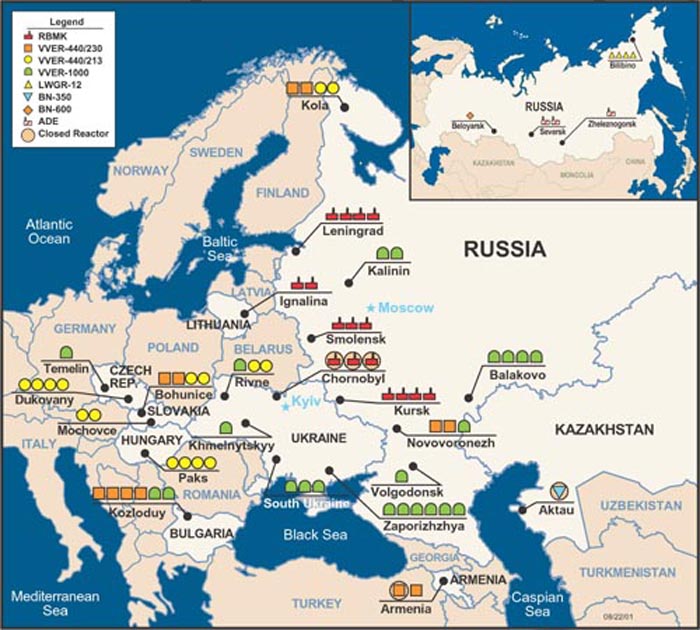
Nuclear power plants participating in the cooperative effort to improve nuclear safety.
(the last operating RBMK reactor at Chornobyl was shut down in December 2000,
and the BN-350 fast breeder reactor in Kazakhstan was shut down in 1999.)
In 1990, the U.S. Department of Energy began a modest program to improve operational safety at Novovoronezh nuclear power plant in Russia. This activity was followed in 1991 with initial efforts to improve safety at Bulgaria's Kozloduy plant. These first steps led to the development of the "Lisbon" safety initiative to enhance the operational safety of Soviet-designed reactors, reduce risks at the least-safe designs, and enhance the capability of regulatory organizations. These goals were endorsed by the G-7 nations at a summit in Munich, Germany, in July 1992. In September of that year, initial funding was provided under an interagency agreement between the Agency for International Development and the Department of Energy.
In 1993, at the G-7 summit in Vancouver, Canada, the United States pledged $100 million to Russia for nuclear safety improvements. Since that time, U.S. efforts have included urgently needed safety work at 23 nuclear power plants with 67 reactors in nine host countries. U.S. work is conducted in cooperation with similar programs initiated by the other G-7 countries-Canada, France, Germany, Italy, Japan, and the United Kingdom, as well as international organizations.
BenefitsThe cooperative effort to improve safety at Soviet-designed nuclear power plants carries significant benefits.
- It reduces the likelihood of a nuclear accident that could destabilize new democratic governments, require a massive influx of international aid, and threaten the viability of nuclear power worldwide.
- It promotes a stable business climate for international investments in countries with Soviet-designed reactors.
- It provides an approach for U.S. commercial firms and industry to participate in nuclear-related business opportunities in the host countries that are participating in cooperative safety activities.
- It provides protection for Europe's public, economic, and environmental health and for U.S. citizens in Europe.
- It promotes a dialog on nuclear issues such as safety and nonproliferation.
The United States supports host countries in their efforts to reduce the most serious risks at Soviet-designed nuclear power plants. The primary activities have included establishing a safety culture, developing infrastructure, implementing maintenance programs, improving physical security, installing safety equipment, developing improved safety procedures, establishing regional centers and installing simulators for training reactor personnel, conducting in-depth safety assessments, and addressing the extraordinary problems at Chornobyl. A further priority is to promote the development of an institutional and regulatory framework for plant design, construction, regulation, and operation that is in keeping with international practices.
ParticipantsThe National Nuclear Security Administration's Office of International Nuclear Safety and Cooperation manages U.S. involvement in the cooperative work. Pacific Northwest National Laboratory provides technical leadership, with project assistance from other U.S. national laboratories, U.S. businesses, host-country nuclear power plants, and host-country scientific organizations.
U.S. specialists work in accordance with federal guidelines and policies of the Department of State and the Agency for International Development and in close collaboration with the Nuclear Regulatory Commission. They also have established working agreements with organizations in the nine host countries, including key government agencies, scientific institutions, engineering and design organizations, and the nuclear power plants.
In addition, many international organizations are involved in the effort to improve the safety of Soviet-designed reactors, such as the Nuclear Energy Agency (NEA) of the Organization for Economic Cooperation and Development, the G-7 Nuclear Safety Working Group (NSWG), the International Atomic Energy Agency (IAEA), the European Bank for Reconstruction and Development (EBRD), the Institute of Nuclear Power Operations (INPO), the World Association of Nuclear Operators (WANO), and the European Union (EU) assistance programs.
More than 90 U.S. commercial firms have provided equipment, training, expert services, and transfer of technology. In addition, the Electric Power Research Institute in Palo Alto, California, continues to transfer methodologies and other information that are being used by the host countries to implement and instill modern safety practices and culture at their nuclear plants.
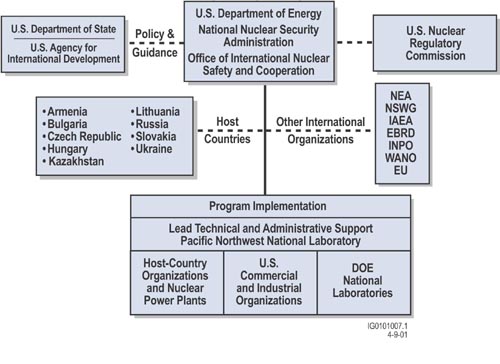
The safety problems at Soviet-designed reactors have several underlying causes. The most significant is the historical isolation of the plants' operators, designers, and regulators. In the closed society of the Soviet Union, these personnel could not exchange information or technology with the international nuclear community and had limited interaction even with their counterparts in Soviet countries.
Another significant cause was a lack of emphasis on safety. Goals for low-cost production of electricity often outweighed safety considerations. Regulatory bodies responsible for enforcing safety standards were ineffective, especially when their safety directives ran counter to production goals.
The new governments of countries with Soviet-designed reactors have made substantial investments in improving the safety of their nuclear power plants. However, their economic and technical resources are insufficient to address many of the risks.
Reactor TypesTwo basic designs, called RBMK and VVER, were used to build all but a few of the operating reactors addressed in cooperative safety efforts.
An RBMK reactor uses graphite to moderate neutrons-or slow them down to improve the efficiency of the nuclear chain reaction. The nuclear fuel is contained in about 1700 pressure tubes. Cooling water passes through the tubes, where fission in the nuclear fuel produces heat that boils the water to produce steam. The steam is routed to a turbine generator, which produces electricity.
A number of problems are inherent in the RBMK design. Power instabilities can lead to increased boiling that in turn increases steam bubbles, or voids, in the cooling water. The voids allow power levels to increase, thus creating even more steam voids (called a positive void coefficient) that result in local power increases and can lead to an uncontrolled nuclear reaction. The other problems are the lack of a containment system to prevent release of radioactive materials to the environment, and noncomformance of the RBMK's emergency core cooling system, fire-protection system, and electronic control-and-protection system with international standards. Additionally, there is concern that if several pressure tubes rupture simultaneously, the force can raise the reactor lid, and release radioactive fission products. Thirteen RBMK reactors are in operation. Chornobyl Unit 4, which was destroyed in the 1986 accident, was an RBMK. The thermal-hydraulic instabilities inherent in an RBMK contributed to the disaster at Chornobyl.
VVER reactors use pressurized light water for core cooling and to moderate the nuclear chain reaction. The VVER reactors are similar to western pressurized light water reactors. Forty-seven VVER reactors are in operation. There are three principal models.
The earliest, the VVER-440/230, has a limited containment system and virtually no emergency core cooling system. Its backup safety systems, fire-protection systems, and electronic control-and-protection systems need improvement.
The VVER-440/213 reactor is an enhanced version of the VVER-440/230. It has an emergency core cooling system. A "bubbler condenser tower" provides some containment. Fire-protection and electronic control-and-protection systems need improvement.
The VVER-1000, the largest and newest model, meets most modern safety standards. It has an emergency core cooling system and a containment building. However, its fire-protection and electronic control-and-protection systems need improvement.
In 1996, two Russian plants with uniquely designed reactors requested U.S. collaboration in safety improvements. The Bilibino plant has four LWGR-12 light-water-cooled, graphite-moderated reactors. The Beloyarsk plant operates a BN-600 breeder reactor, which is cooled by liquid sodium.
A Soviet-designed BN-350 fast breeder reactor at Aktau, Kazakhstan, was shut down in 1999.
Reducing Risks as Reactors Continue to OperateInternational safety specialists have encouraged the host-country governments to shut down the older, less-safe reactors, including the RBMK and VVER-440/230 designs and some progress is being made.
Chornobyl Unit 3, the last operating reactor at Chornobyl, was shut down in December 2000. Kozloduy Unit 1 and Unit 2 are scheduled to be shut down before 2003 and Unit 3 and Unit 4 before the currently scheduled dates of 2008 and 2010. Agreements also have been reached to shut down Ignalina Unit 1 in Lithuania by 2005 and Bohunice Unit 1 and Unit 2 in Slovakia before the end of their planned lifetimes.
These agreements were reached in connection with international support for alternative resources. Meanwhile, many Soviet-designed reactors will continue to operate, and more modern Soviet-designed reactors will continue to benefit from international safety efforts. As a result, the United States and the international community continue to work with the host countries to improve safety until these reactors comply with international standards or are shut down.
Is It a Plant or a Reactor? |
||
|
Soviet-designed nuclear power plants can have multiple reactors, which
can share common facilities. |
||
|
Armenia Bulgaria Czech Republic Temelin plant Hungary Kazakhstan Lithuania |
Russia Balakovo plant Four VVER-1000 reactors Beloyarsk plant Bilibino plant Kalinin plant Kola plant Kursk plant Leningrad plant Novovoronezh plant Rostov plant Smolensk plant |
Slovakia Ukraine Khmelnytskyy plant Rivne plant South Ukraine plant Zaporizhzhya plant |
|
BN = Breeder reactor. *Plant has been shut down since 1999. Efforts will be focused on decommissioning
activities. |
||
Activities to Reduce Risk and Improve Safety
Since the inception of these efforts, U.S. specialists have initiated more than 300 joint projects. Many are completed but more than 100 projects are currently ongoing. Many projects reduced risks immediately by decreasing the possibilities of equipment malfunction and operator error.
Projects are organized into six key areas.
- Management and operational safety projects increase the safety of day-to-day operations by training operators, establishing safe operating procedures, and supplying up-to-date maintenance technology and training.
- Engineering and technology projects reduce operating risks by upgrading the safety equipment and systems of nuclear power plants. Projects are focused on improvements in fire safety, radiation confinement, and reactor safety systems.
- Plant safety assessment projects improve the abilities of designers, operators, and regulators to evaluate the safety of their plants through the use of internationally accepted methodologies and computer analysis codes.
- Fuel-cycle safety projects improve the handling and storing of reactor fuel and the operation of nuclear-fuel-cycle facilities.
- Nuclear safety institutional and regulatory framework projects address the need for effective regulatory systems in countries with Soviet-designed reactors.
- Chornobyl initiatives to improve the shelter over the destroyed Unit 4 reactor and protect shelter workers; shut down and deactivate the Chornobyl plant, including constructing a heat plant for use during deactivation activities; and establish an international Chornobyl center, including a nuclear safety research laboratory in Slavutych, Ukraine-the worker town near Chornobyl.
Key Accomplishments
Safety Synergy
Perhaps the most critical safety improvements support control room reactor operators to make correct decisions during an emergency. Key to this support are full-scope control room simulators, safety parameter display systems, and symptom-based emergency operating instructions-all standard in the United States and being introduced to Soviet-designed reactors through cooperative safety efforts. Full-scope control room simulators allow reactor operators to safely practice dealing with realistic emergency scenarios; safety parameter display systems link thousands of plant sensors to a graphical computer interface that provides up-to-date information on plant safety systems; and symptom-based emergency operating instructions provide effective responses whenever off-normal conditions signal a potential emergency. Together, these measures give reactor operators the best tools available for safe operations.
Technology TransferU.S. and host-country organizations are conducting joint projects to manufacture safety equipment, perform safety assessments, and use advanced technology in staff training. After U.S. training, a Lithuanian company manufactured replacement modules for reactor control-and-protection systems. Through work with U.S. engineers, a company in Ukraine and another in Russia developed the capability to manufacture highly effective fire doors. Companies in Russia are developing the capability to produce nuclear grade valves and circuit breakers. The United States is transferring computer analysis codes and methodologies that enable host-country specialists to assess plant safety, identify risks, and set priorities for safety upgrades.
TrainingWith U.S. support, Russia and Ukraine each have established a successful nuclear training center to accelerate the transfer of skills and safety information. The instructors have developed and conducted job-specific maintenance and operations courses, along with courses in employee safety and supervisory skills.
The instructors have worked with U.S. training specialists to expand the training programs to other Ukrainian and Russian plants. Plant instructors are developing and conducting site-specific training courses.
U.S. training specialists also are working with instructors in Armenia, Bulgaria, Lithuania, and Slovakia to improve their training programs.

Simulator in use for training operators at the Khmelnytskyy plant in Ukraine.
Simulator Development
Five full-scope and four analytical simulator projects were completed by the end of September 2000. Six additional full-scope simulator projects are in progress, and modifications were made to the Kozloduy full-scope simulator. Through the cooperative projects, host countries are acquiring the capabilities 1) to use simulators in training operators to effectively handle emergency situations and 2) to update and maintain their simulators.
Emergency Operating Instructions Four plants with Soviet-designed reactors have implemented symptom-based emergency operating instructions-Ukraine's Chornobyl plant, Russia's Novovoronezh plant, Slovakia's Bohunice plant, and the Czech Republic's Dukovany plant. Three more plants, Bulgaria's Kozloduy, Hungary's Paks, and Lithuania's Ignalina, plan to implement emergency operating instructions within the next year. Five more plants have drafted such instructions. Symptom-based instructions enable control room operators to stabilize a reactor quickly during an abnormal event. The time saved can prevent a minor problem from escalating into a larger accident.
U.S. specialists have transferred the skills for developing symptom-based instructions to pilot plants in Ukraine, Russia, and Central and Eastern Europe. U.S. and host-country specialists now are validating the instructions for use at Soviet-designed reactors.
Safety Maintenance TechnologiesThe United States has supplied up-to-date tools and training for maintenance workers at the five plants with RBMK reactors. The workers now maintain crucial piping systems with pipe lathe/weld-preparation machines, valve-seat resurfacing equipment, and vibration monitoring and shaft alignment systems. They use ultrasonic and other nondestructive examination equipment to find flaws in pipes and other key reactor components.
Preventive maintenance workers at the Armenia plant, Bulgaria's Kozloduy plant, Ukraine's Chornobyl plant, and Russia's Leningrad, Smolensk, Bilibino, Kursk, and Novovoronezh plants are using infrared thermography cameras to detect "hot spots" in failing equipment and faulty components and connections in electrical and instrumentation and controls systems. In addition, workers at Lithuania's Ignalina plant are using advanced equipment to detect the onset of insulation breakdown in the main generator and high-voltage wiring, preventing fires and potential system failures.
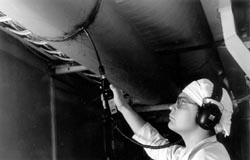 Ultrasonic inspection equipment is now used in Ukraine to locate flaws in pipes. |
 Fire detection equipment like that delivered to Soviet-designed plants. |
 Control-and-protection system panel at Ignalina Unit 1. |
Engineered Safety Upgrades
Control room operators at 11 plants now have safety parameter display systems and seven more systems are scheduled for installation. The systems enable the operators to assess abnormal conditions rapidly and take corrective actions (using symptom-based emergency operating instructions, where those are implemented).
The United States has supplied basic fire-protection equipment to plants in Armenia, Ukraine, Russia, and Bulgaria. Russia's Kola and Kursk plants and Bulgaria's Kozloduy plant received backup power systems to supply vital electricity during emergency shutdowns. Russia's Kursk and Novovoronezh plants received mobile pumping units for emergency water supplies. With U.S. support, workers at Armenia's nuclear power plant constructed a nuclear service-water system as an alternative to the plant's cooling tower, which is vulnerable to earthquake damage.
With U.S. support, Kola staff members have substantially reduced leaks in the radiation confinement system. Lithuania's Ignalina plant has received reliable replacements for the aging modules in its electronic control-and-protection system. With U.S. support, additional reactor-trip systems have been installed at Ignalina's two reactors. U.S. and host-country experts have defined methodologies for conducting safe-shutdown analyses (i.e., evaluate if the plant can safely shut down if there is a fire) at Soviet-designed reactors, and pilot analyses were conducted at Ukraine's Zaporizhzhya plant and Russia's Smolensk plant.
Safety Assessment ProjectsThe U.S. has sponsored safety assessment efforts at 13 plants (each plant may have several reactor units) in eight countries representing five Soviet reactor designs. Active projects are in progress at seven plants in Russia and Ukraine. The United States provides technical guidance and financial assistance to plant operators and their technical support organizations, so that they obtain the capability to take responsibility for safety assessments. The in-depth assessments include deterministic analyses based on accident scenarios. The analyses determine whether the plant can adequately cope with the accident scenario. In addition, probabilistic analyses are used to examine the likelihood of individual component failures and how components are interlinked. Such analyses help identify vulnerable components and help prioritize plant modifications and maintenance activities needed to improve safety. As plant staff carry out safety assessment activities, they become part of a cadre of experts on plant safety. The result is the development of a safety culture that helps ensure safe operations over the life of the plant.
Safety Projects at BilibinoRussia's extremely isolated Bilibino plant has had difficulty retaining skilled workers, finding replacement parts, and communicating reliably with the outside world. Nome, Alaska, is just 850 miles and predominantly downwind from Bilibino. The North Slope of Alaska also is directly downwind of the plant. With U.S. support, the plant installed a satellite-based communications device in 1999. The device will serve as an early-warning system while giving plant personnel the ability to exchange maintenance and safety information regularly with U.S. and Russian personnel. U.S. training specialists are working with Bilibino instructors to improve training programs, and the United States is supplying high-priority maintenance equipment.
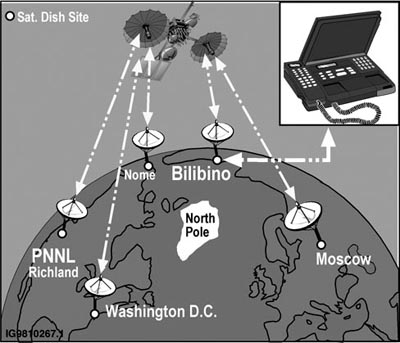
Satellite-based communications systems put in place to enhance information exchange
between Bilibino plant staff and off-site experts in Russia and the United States.
Spent-Fuel Storage
The United States has worked with Ukraine to develop a dry-cask system for storing spent fuel at the Zaporizhzhya plant. The plant's pools for storing spent-fuel rods are nearly full. The United States delivered equipment and trained Ukrainian personnel to build and regulate a safe, modern, dry-cask storage system.
Regulatory CapabilitiesRegulatory experts from Ukraine and Russia have participated in extensive training with U.S. experts, developing capabilities for effective oversight of nuclear power plants.
International Nuclear Safety CentersInternational Nuclear Safety Centers have been established to date in Armenia, Kazakhstan, Lithuania, Russia, Ukraine, and the United States to promote the open exchange of nuclear safety information, to cooperate in the development of technologies associated with nuclear power engineering, and to be international centers for the collection and dissemination of important information on nuclear safety and technical improvements in nuclear technology.
The centers sponsor scientific research activities in the form of collaborative projects between their international partner organizations, each of which have established nuclear safety centers in their respective country. These activities are focused on Soviet-designed nuclear power plants in Russia and Eastern Europe.
Historically, the United States, Russia, as well as the other countries, have had significant research programs on many of the topics that are vital to the safety of nuclear reactors. Unique capabilities and strengths have been developed in each country over the years, and the political and technological leaders of those countries recognize that encouraging and facilitating collaborative research will advance this combination of capabilities and strengths. The centers have followed up by working together to initiate activities and collaborative research projects that address internationally identified nuclear safety issues. The thrust of these projects is to use the resources and talents of the scientists associated with the centers to do research that will benefit all participating countries.
Internet-based technologies are used to disseminate the results of the projects and other important information on nuclear safety issues to the entire technical community, and to establish immediate and cost-effective communication channels among all involved organizations.
Chornobyl InitiativesAddressing an urgent safety concern, workers have stabilized a ventilation stack damaged by the 1986 accident at Chornobyl. The repairs marked the first resolution of a significant safety problem stemming from the disaster. The Ukrainian contractor completed the work on schedule, demonstrating Ukraine's ability to manage and perform high-quality work under an international contracting arrangement. U.S. specialists provided technical support that minimized worker exposure to the high radiation levels around the stack. The United States, Canada, and Ukraine funded the project.
Ukrainian and international specialists have begun carrying out the Shelter Implementation Plan, which aims to prevent collapse of the shelter around the ruined reactor Unit 4, protect workers and the environment, and address the long-term stability and containment concerns. U.S. specialists provided the primary technical support for developing the plan. The United States has provided shelter workers with equipment and training to reduce their radiation exposure, improve industrial safety, and suppress the radioactive dust inside the shelter.
U.S. personnel are working with Ukrainian specialists to develop technical strategies for shutting down and deactivating the Chornobyl plant. The United States also is working with Ukraine to complete the construction of a new heating plant. A new heat source must be available to maintain safety systems at Chornobyl when deactivation begins.
Joint projects in data analysis, spent-fuel management, and reactor closure are under way at the International Chornobyl Center for Nuclear Safety, Radioactive Waste and Radioecology, established in 1996 in Kyiv. Ukraine also established the center's Slavutych Laboratory in 1996 in the town of Slavutych, near Chornobyl. The United States has supported development of the center and has provided a satellite communications system, which gives the center reliable telephone access to the rest of the world, as well as videoconferencing capability and electronic access to the information databases of partnering organizations. U.S. personnel have provided training for center staff in management skills and the evaluation of nuclear-related technologies.
The United States and Ukraine collaborated to create the International Radioecology Laboratory as a new subsidiary of the International Chornobyl Center. The laboratory facilitates Ukrainian and international research on the effects of radiation on plants and animals.
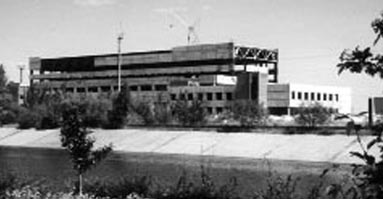
Replacement heat plant for Chornobyl.
Performance Measurement
Results published in the latest Office of International Nuclear Safety and Cooperation annual performance measurement report show that U.S. efforts have improved safety at Soviet-designed nuclear power plants.1 Projects have succeeded in correcting major safety deficiencies, and equipment, technology, and processes vital to the safe operation of nuclear power plants have been transferred to Soviet-designed nuclear power plants and to host-country organizations involved in overseeing nuclear plant operations. Plant operations and institutional procedures now more closely conform to internationally recognized practices. Progress highlights for the six key technology areas examined in the performance measurement report are summarized below.
Operational Safety- Approximately 85 percent of the specific analyses necessary to validate the emergency operating instructions for all of the pilot plants have been identified and the analyses are under way.
- The Ukrainian National Standard for Quality Assurance at Ukraine's nuclear power plants was issued as a regulatory normative document.
- Procedure development and training were completed on quality assurance assessments and audits.
- Pilot procedure development and training on event analysis and reporting procedures were completed at the Zaporizhzhya plant.
- The Balakovo analytical simulator and the upgrade to the Balakovo Unit 4 full-scope simulator were completed.
- The upgrades to the Zaporizhzhya Unit 5 full-scope simulator were completed.
- The safety parameter display systems for the Khmelnytskyy Unit 1 and Zaporizhzhya Unit 5 full-scope simulators were completed.
- At least two training courses have been transferred to each nuclear power plant in Russia and Ukraine.
- The RBMK Safety Maintenance Technology Transfer and Training project was completed.
- The Ukraine Nondestructive Examination Training and Certification Center was refurbished.
- An inspection procedure for ultrasonic inspection of austenitic pipe welds was developed.
- The Ukraine reliability database at the Khmelnytskyy site was installed.
- The Russian reliability database communications network was connected to the Internet.
- Progress in installation of VVER-1000 safety parameter display systems in 1999 was excellent. Delays associated with plant outages that resulted from regional flooding and from the unavailability of fuel were experienced. Nevertheless, six units are now essentially completed, and the project team is making excellent progress. Excellent progress also has been realized with the VVER-440 safety parameter display systems.
- In Russia, excellent progress was made in completing the safety assessments in accordance with guidance developed by Russian regulatory authority for Leningrad and Novovoronezh plants. Production plans now exist for the in-depth safety assessment report for both of these projects.
- At the Kola plant, the Level 1 internal events probability risk assessment was completed.
- At the Leningrad, Novovoronezh, and Kola plants, the transfer of U.S. technology resulted in the development of a core safety analysis capability at each plant with the capabilities to carry out and lead internationally accepted safety assessments. If this capability can be sustained, it will lead to significant improvements in the operational safety of these three plants.
- Progress in code assessment projects (RELAP5 validation for VVER and RBMK applications) was satisfactory in 1999. The startup and demonstration phase, initiated in 1997, was completed, and specific validation plans for both VVER and RBMK applications were completed with the agreement of all the host-country organizations participating in the projects. In 1999, Ukraine and Lithuania became involved in the code assessment activities with good success. Also in 1999, implementation of code configuration and maintenance activities at the Russian International Safety Center commenced. This activity is an important element in developing long-term sustainability of a good safety infrastructure.
- Activities continue to build a sustainable regulatory infrastructure that will ensure the safe operation, decontamination, and decommissioning of nuclear facilities. These activities are closely coordinated with the Nuclear Regulatory Commission.
The United States is continuing its participation in this comprehensive, cooperative effort to reduce risks at nuclear reactors worldwide, with the emphasis on Soviet-designed reactors. Since this effort began in 1993, the approach taken to achieving its goals have been refined to 1) implement risk reduction through equipment upgrades at the highest-risk reactors; 2) improve operational practices and training at all nuclear power plants; and 3) provide the necessary technology, training, and infrastructure support so that these safety improvements can become self-sustaining.
International assistance efforts alone cannot resolve the safety deficiencies inherent in host-country nuclear programs. The goal of external assistance efforts is to help host countries develop their own capability to operate and regulate nuclear power plants more safely. As their economies improve, the host countries will be able to sustain and extend such improvements by their own efforts until they can reach internationally accepted standards in the operation and regulation of their nuclear programs.
A substantial element of this approach is the transfer of manufacturing technologies, training methodologies, and safety analysis capabilities to host countries. Technology transfer methods include information exchanges, technical collaborations, personnel exchanges, licensing of U.S. technologies, and formation of joint U.S./host-country companies.
The approach is based on the assumption that economic and energy market reforms will take hold in the host countries to a level sufficient for them to make substantial investments in nuclear safety in the near future. This improvement has occured already in the countries of Slovakia, Hungary, and the Czech Republic, and has resulted in reduced levels of assistance activities. In the remaining host countries of Armenia, Bulgaria, Kazakhstan, Lithuania, Russia, and Ukraine, economic reforms and nuclear safety investments are taking longer to be realized.
Major activities planned for 2001 and 2002 are described briefly below.
- Chornobyl workers will complete the construction of a heat plant to support reactor plant closure activities.
- Additional simulator projects will be completed for five reactors in Russia and Ukraine.
- Emergency operating instructions will be implemented at the Kozloduy plant in Bulgaria, the Rivne and Zaporizhzhya plants in Ukraine, the Balakovo and Kola plants in Russia, and the Ignalina plant in Lithuania.
- Safety parameter display systems will be installed at three more reactors in Ukraine and one more in Russia, thus completing this project.
- Plant-specific safety assessments will be completed at three plants in Russia and four plants in Ukraine, leaving a cadre of experienced safety assessment specialists at each plant.